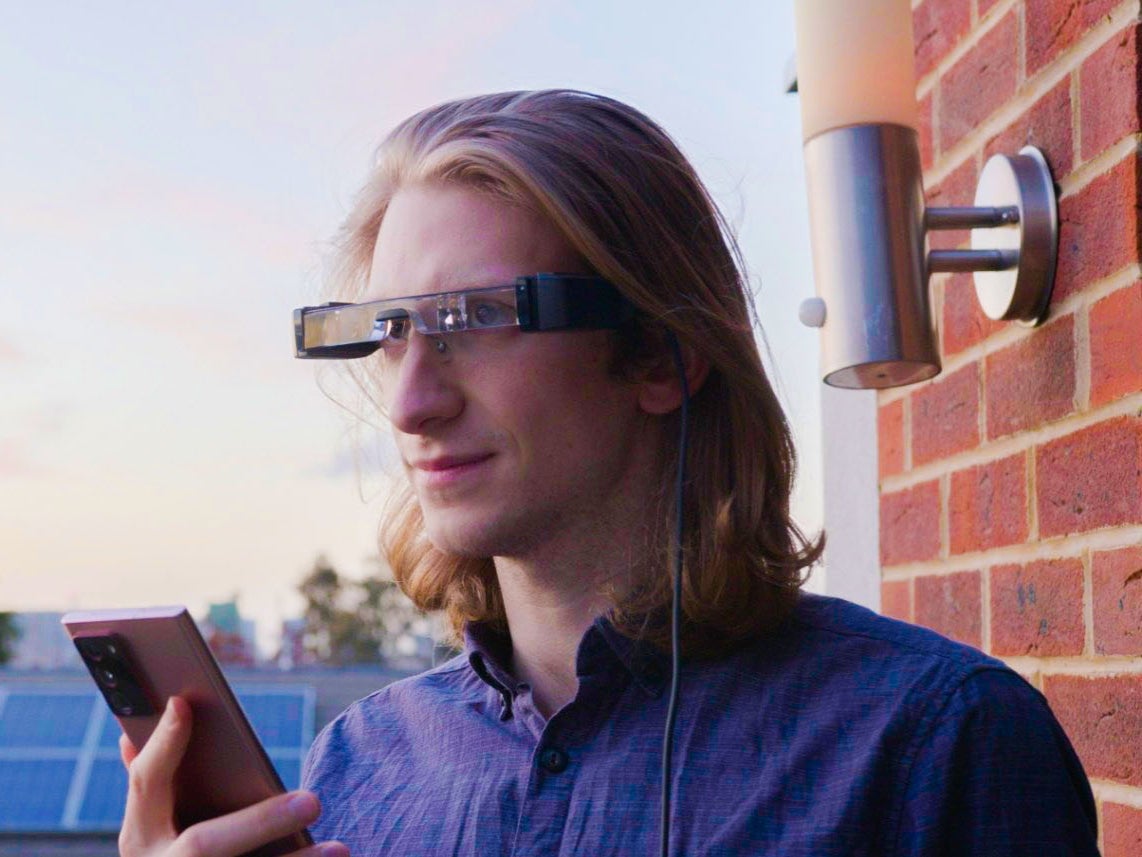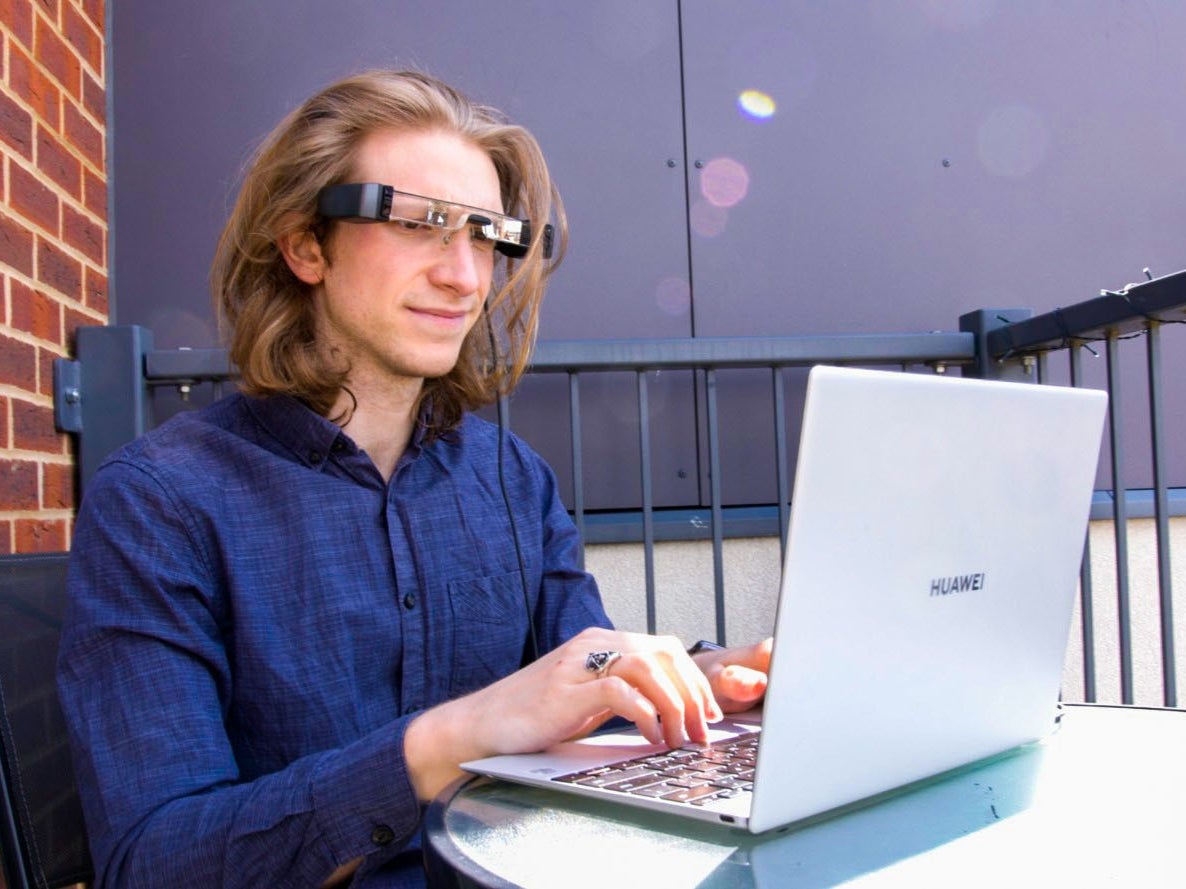
Smart glasses, according to the big technology giants, are the next evolution of personal computers.
Google, after a failed attempt to make Google Glass popular, purchased a startup to make a second attempt. Facebook has been continually developing smart glasses to build a mixed-reality future. Apple has been long-rumoured to be doing the same, with CEO Tim Cook saying industries will be changed “entirely” and nothing will be left “untouched”.
Currently, all of this is vapourware – conceptual products that are not available to buy. What is available to buy are Epson’s Moverio BT-40, a £600 pair of “second-screen smart glasses”, as the company calls them.
These glasses plug into a Windows computer or an Android smartphone via a USB-C connection, and act as a translucent second monitor directly in front of your eyes. For what they do, they work well. They are comfortable, lightweight, and glancing between a laptop screen and the glasses’ 1080p display became surprisingly natural.
When I wasn’t looking at the display the glasses generated, I forgot it was there – the same way the brain tunes out things in your peripheral vision. Double-tapping the side of the glasses turns off the display completely, which is a nice touch too. For the most part, there was little difference between sitting, stationary, looking at my MacBook Air and my second display and glancing between my PC and the view in my glasses.
But few people wear glasses to be stationary, and smart glasses less so. As such, there are practical and obvious drawbacks to the BT-40s: these glasses should be completely wireless, as headphones became, and designed so that the wearer does not look like they walked from a 90s sci-fi film.
Epson says that currently the best way to balance weight, comfort, and performance is via a cable, but would not say more about whether they are developing towards the ideal of smart glasses that we all have. And while these are not issues that the BT-40s run into, because their capabilities are so limited, but moments after putting them on it is hard not to think about how they could develop.
The technology should be less obtrusive – while also balancing privacy – to provide features like augmented reality mapping, hands-free on-the-spot access to information, and entertainment. Unfortunately, these are all things that simply do not exist yet.
Plugging in Samsung’s Note 20 Ultra, which has a build-in desktop called Dex, I was hopeful that the Google Maps app could be relegated to the left-hand side, perhaps with Twitter on the right, and I could possibly navigate London more easily than using my phone. Not so – windows remain solely in the middle, blocking a cohesive mesh between reality and the digital space.

Lastly, until there is a suitable hand-tracking user interface like the one Facebook is developing for the Quest, it should be controlled by the phone. I’ve used smart glasses – more accurately, audio glasses – with built-in tactile controls, and they are not yet more convenient than the buttons and swipes on everyone’s most-used device. This is perhaps unfair criticism – that software has not been built for a platform that does not exist – but on the whole, the BT-40s currently feel like a canvas waiting for paint.
What this did reveal, however, is the path augmented reality glasses are likely to tread on their way to launch: the consumer product must have the capacity to switch between acting as your primary screen – perhaps for work – and a peripheral (ambient?) display for play.
It is vital this balance is worked out because wearable computers are not laptops, or phones. They will inevitably be harder to walk away from – a task that is already drastically challenging in the face of increasing digital workplace surveillance and the impossibility of putting down our phones, through both the convenience they could provide and the pressure that could be placed upon us.
We already exist in a world of always-on email and work-provided PCs, one that could understandably worsen when the computer exists on your face every second of the waking day. The BT-40’s tether is a physical reminder of this metaphorical entrapment.

Yet the technology giants building what will probably be the smart glasses most people will use are also likely to capitalise on these issues. Apple’s motivation are the most straightforward: the iPhone has transformed society to an unimaginable degree, making Apple the richest company in the world, and it’s unlikely Apple would want to relinquish that kind of clout.
Google, specifically Google Search, and its DeepMind artificial intelligence, is built on the company’s ability to organise and understand the world’s information. If Google can provide that in a wearable consumer product, in exchange for collecting more contextual data, it could be invaluable for the company.
But Google could also potentially gather a huge amount of personal and contextual information from smart glasses, if they can push public opinion just so. There is already research into emotion detection algorithms powered by the kinds of facial recognition software that we could see built into smart glasses, and even if this is simply hype companies could always turn tracking inwards to determine a variety of personality traits that would be a gold mine for ad businesses.
Facebook, which makes money through advertising like Google does, could benefit through similar means – but they have an even greater interest in being the victor. Unlike Google and Apple, who have a duopoly over the smartphone market, Facebook has no real hardware apart from the Oculus Quest and the comparatively little-used Portal after its attempt to build a phone flopped. And the phone is power. Apple’s dominance in both its software and the hardware has severely impacted the social media giant and, as the Epic Games trial has revealed, allows it to interfere with the business plans of every app on its platform. With Mark Zuckerberg giving numerous interviews about how virtual and augmented reality is the future, and the potential to build a revenue stream through a virtual metaverse, it is unlikely that Facebook let the opportunity to have similar levels of control pass it by.
Having now taken off the smart glasses permanently, there is a part of me that wants to put them back on. Six out of every ten people in the UK wear glasses, and I am among them; already at home with the hardware, as it were, the prospect of adding greater utility to what I’m already wearing is very attractive. But my concerns over software, surveillance, and addiction – all of which we have seen play out in the smartphone and social media industries – makes me hesitant. These simple smart glasses are a glimpse into the future, undoubtedly, but I can’t be sure that the companies building them have learned from the lessons of the past.







